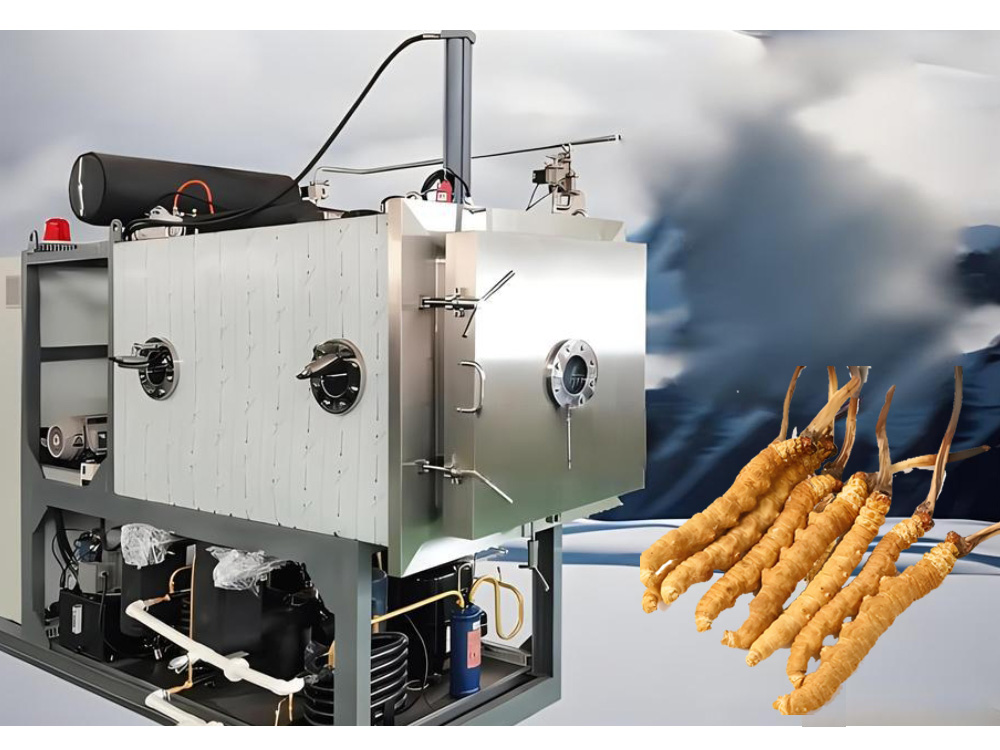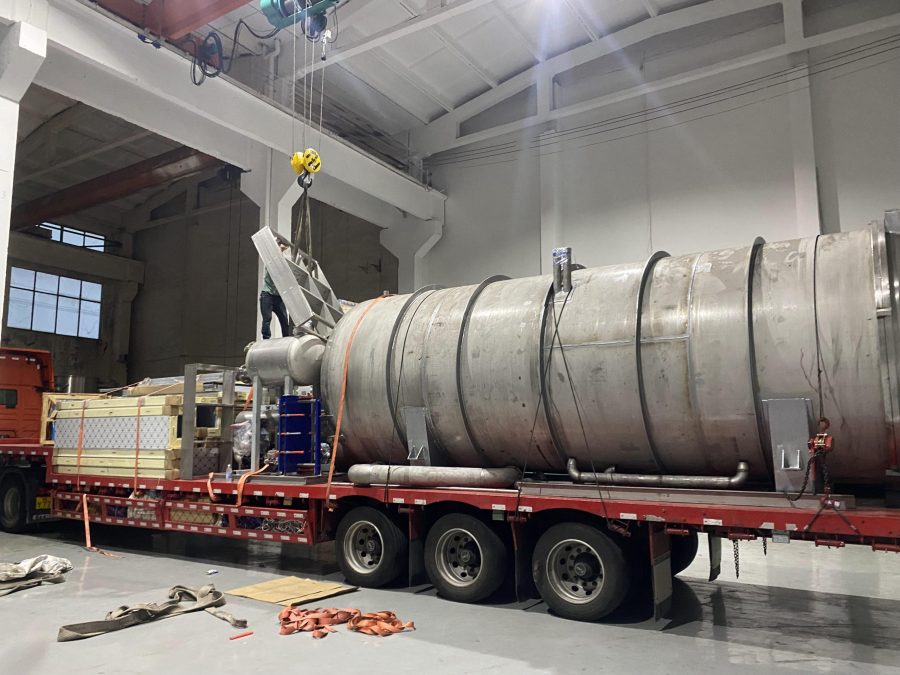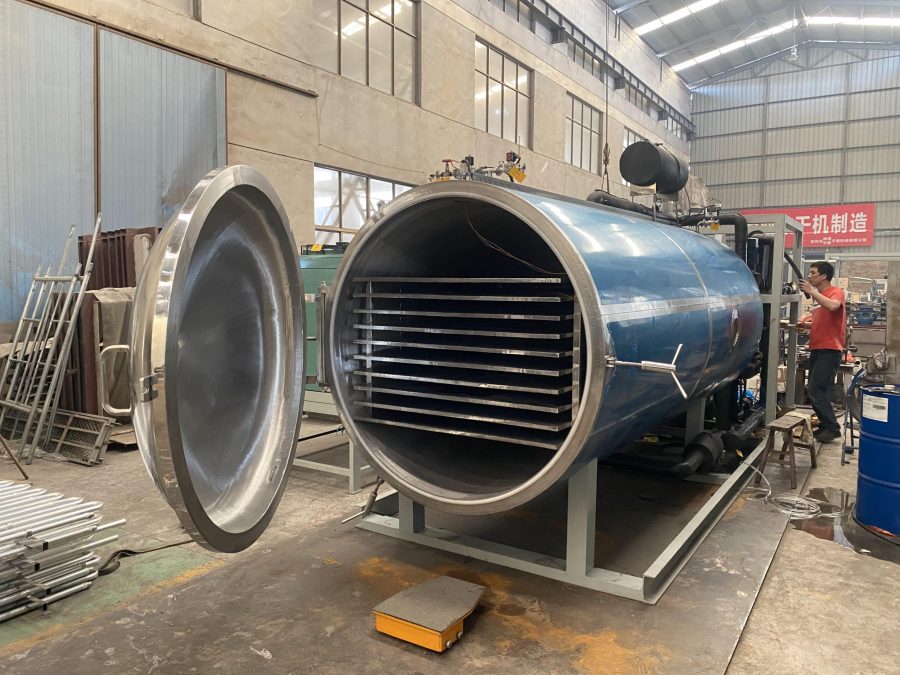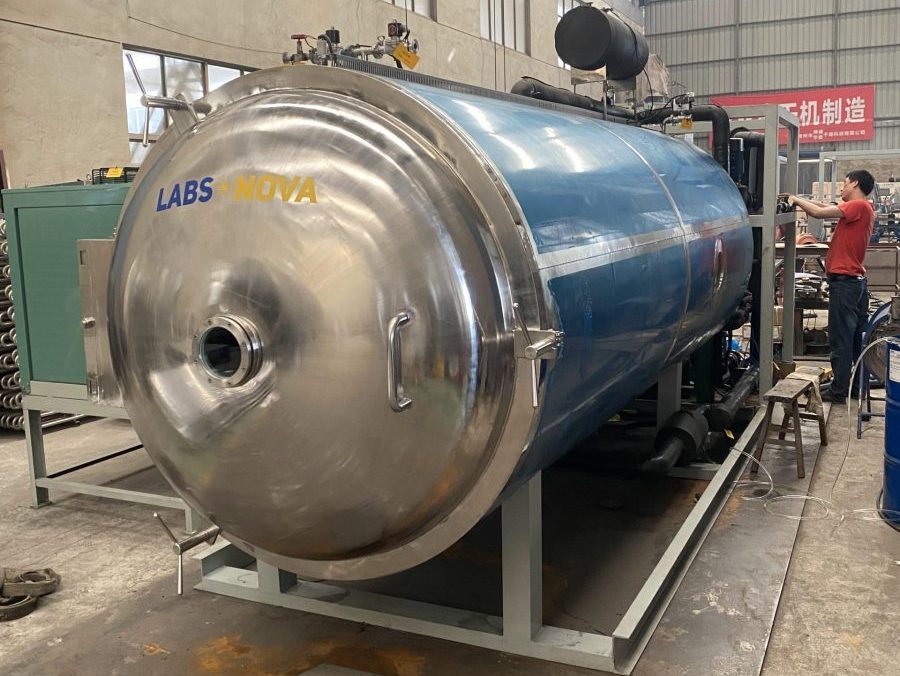Overview
The basic principle of freeze-drying is based on the three state changes of water. Water can be in solid, liquid, and gas states, and these three states can both transform and coexist with each other. When water is at the triple point (temperature is 0.01 ℃, water vapor pressure is 610.5Pa), water, ice, and water vapor can coexist and balance with each other. In a high vacuum state, using the sublimation principle, the moisture in the pre frozen material is directly sublimated into water vapor in the ice state without melting the ice, thereby achieving the purpose of freeze-drying. Freeze dried products are sponge like, have no shrinkage, excellent rehydration ability, and contain very little water. After packaging, they can be stored and transported for a long time at room temperature. Due to the unparalleled advantages of vacuum freeze-drying compared to other drying methods, this technology has been increasingly favored by people since its inception, and its application in medicine, biological products, and food has become increasingly widespread. Serum, bacterial strains, traditional Chinese and Western medicine and other biological products are mostly bioactive substances, and vacuum freeze-drying technology also provides a good solution for preserving biological activity.
Detailed explanation
Freeze drying is a technique that utilizes the principle of sublimation for drying. It involves rapidly freezing the dried substance at low temperatures, and then in an appropriate vacuum environment, directly sublimating the frozen water molecules into water vapor to escape. The product obtained from freeze-drying is called lyophilizer, and this process is called lyophilization. The substance is always at a low temperature (frozen state) before drying, and ice crystals are evenly distributed in the substance. During the sublimation process, concentration will not occur due to dehydration, and side effects such as foam and oxidation caused by water vapor are avoided. The dry substance appears as a porous sponge, with a basically unchanged volume, and is highly soluble in water to restore its original state. To prevent the physical, chemical, and biological denaturation of dry substances to the greatest extent possible. The freeze dryer system consists of a refrigeration system, a vacuum system, a heating system, and an electrical instrument control system. The main components include a drying oven, condenser, refrigeration unit, vacuum pump, heating/cooling device, etc. Its working principle is to freeze the dried item below the triple point temperature, and then under vacuum conditions, the solid water (ice) in the item is directly sublimated into water vapor, which is removed from the item and dried. After pre-treatment, the materials are sent to the quick freezing warehouse for freezing, then sent to the drying warehouse for sublimation and dehydration, and then packaged in the post-processing workshop. The vacuum system establishes low-pressure conditions for the sublimation drying chamber, the heating system provides sublimation latent heat to the material, and the refrigeration system provides the required cooling capacity to the cold trap and drying chamber. This equipment adopts efficient radiation heating, and the materials are uniformly heated; Adopting an efficient water trap and achieving rapid defrosting; Adopting an efficient vacuum unit and capable of achieving oil-water separation; Adopting a parallel centralized refrigeration system with multi-channel on-demand cooling, stable operating conditions, and favorable energy-saving; Adopting artificial intelligence control, with high control accuracy and convenient operation. The quality requirements for freeze-dried products from Xinyu Instrument Network are: unchanged biological activity, uniform appearance and color, full form, firm structure, fast dissolution rate, and low residual moisture. To obtain high-quality products, there should be a comprehensive understanding of the theory and process of freeze-drying. The freeze-drying process includes three stages: pre freezing, sublimation, and re freeze-drying. Reasonably and effectively shortening the freeze-drying cycle has significant economic value in industrial production.
Freezing of a product
When the solution is rapidly frozen (cooling by 10-50 ℃ per minute), the grain size remains visible under the microscope; When frozen slowly (1 ℃/min), the crystals formed are visible to the naked eye. Coarse crystals leave large gaps in sublimation, which can improve the efficiency of freeze-drying. Fine crystals have smaller gaps after sublimation, which hinders the sublimation of the lower layer. The finished product of rapid freezing has delicate particles, uniform appearance, large specific surface area, good porous structure, fast dissolution rate, and relatively strong moisture absorption of the finished product. There are two ways to pre freeze drugs in a freeze dry machine: one is to cool the product and the drying oven simultaneously; Another method is to wait for the drying oven shelf to cool down to around -40 ℃ before placing the product in it. The former is equivalent to slow freezing, while the latter falls between fast freezing and slow freezing, and is often used to balance freeze-drying efficiency and product quality. The disadvantage of this method is that when the product is put into the box, the water vapor in the air will quickly condense on the shelf. In the early stage of sublimation, if the board heats up quickly, the large area of sublimation may exceed the normal load of the condenser. This phenomenon is particularly significant in summer. The freezing of the product is in a static state. Experience has shown that undercooling can easily occur to the point where the product temperature has reached the eutectic point. However, the solute still does not crystallize. In order to overcome the phenomenon of undercooling, the freezing temperature of the product should be lower than one range below the eutectic point and maintained for a period of time until the product is completely frozen.
The conditions and speed of secondary sublimatio
When the saturated vapor pressure of ice at a certain temperature is greater than the partial pressure of water vapor in the environment, it can begin to sublime; The suction and capture of water vapor by a condenser with a lower temperature than the product is a necessary condition for maintaining the temperature rise. The distance traveled by gas molecules between two consecutive collisions is called the average free path, which is inversely proportional to pressure. At normal pressure, its value is very small, and the sublimated water molecules are easily collided with the gas and return to the surface of the steam source, resulting in a slow sublimation speed. As the pressure decreases below 13.3Pa, the average free path increases by 105 times, significantly accelerating the sublimation rate. The detached water molecules rarely change their orientation, thus forming a directed steam flow. The vacuum pump plays a role in extracting permanent gas in the freeze dry machine to maintain the necessary low pressure for sublimation. 1g of water vapor expands to 10000 liters at 13.3Pa, while it is 1.25L at atmospheric pressure. It is impossible for an ordinary vacuum pump to extract such a large volume per unit time. The condenser actually forms a vacuum pump specifically designed to capture water vapor. The temperature for product and coagulation is usually -25 ℃ and -50 ℃. The saturated vapor pressures of ice at this temperature are 63.3 Pa and 1.1 Pa, respectively, resulting in a significant pressure difference between the sublimation and condensation surfaces. If the partial pressure of non condensable gases in the system can be ignored at this time, it will promote the water vapor sublimated from the product to reach the surface of the condenser at a certain flow rate and form frost. The sublimation heat of ice is about 2822J/g. If the sublimation process does not supply heat, the final product can only compensate for the sublimation heat by reducing internal energy until its temperature is balanced with the condenser temperature, and then the sublimation stops. In order to maintain the temperature difference between sublimation and condensation, it is necessary to provide sufficient heat to the product.
Triple sublimation process
In the first stage of heating (extensive sublimation stage), the temperature of the product should be one range below its eutectic point. Therefore, the shelf temperature needs to be controlled. If the product has been partially dried but the temperature exceeds its eutectic point, the product will melt. At this time, the melted liquid will be saturated with ice, but not with solute. Therefore, the dried solute will quickly dissolve and eventually condense into a thin rigid block, with an extremely poor appearance and poor dissolution rate. If the product melts in the later stage of large-scale sublimation, Due to the small amount of melted liquid, it is absorbed by dry porous solids, resulting in defects in the blocky material after freeze-drying. When dissolved with water, a slower dissolution rate can still be observed. In a large number of sublimation processes, although there is a significant temperature difference between the shelf and the product, the sublimation heat absorption is relatively stable due to the fact that the plate temperature, condenser temperature, and vacuum temperature remain basically unchanged, and the product temperature is relatively constant. As the product dries layer by layer from top to bottom, the resistance to ice sublimation gradually increases. The temperature of the product will also slightly increase accordingly. Until the presence of ice crystals is no longer visible to the naked eye. At this point, over 90% of the moisture has been removed. The process of large-scale sublimation has basically ended. In order to ensure that the entire box of products is fully sublimated, the plate temperature still needs to be maintained for one stage before proceeding to the second stage of heating up. The remaining percentage of water is called residual water, which differs from free state water in terms of physical and chemical properties. Residual water includes chemically bound water and physically bound water, such as crystallized water, water bound by proteins through hydrogen bonds, and adsorbed water on solid surfaces or capillaries. Due to the binding force of residual moisture, its saturated vapor pressure decreases to varying degrees, resulting in a significant decrease in drying rate. Although increasing the temperature of the product promotes the gasification of residual moisture, if the temperature exceeds a certain limit, the biological activity may also sharply decrease. The maximum drying temperature to ensure product safety should be determined by experiments. Usually, in the second stage, we set the plate temperature to around 30 ℃ and keep it constant. In the early stage of this stage, due to the increase in plate temperature, there is less residual moisture and it is not easy to gasify, so the temperature of the product rises rapidly. But as the product temperature gradually approaches the plate temperature, the heat conduction becomes slower and requires patience to wait for a considerable period of time. Practical experience has shown that the drying time of residual moisture is almost equal to the time of a large amount of sublimation, and sometimes even exceeds it.
Four freeze-drying curves
Record the changes in shelf temperature and product temperature over time to obtain the freeze-drying curve. A typical freeze-drying curve system divides the temperature rise of the shelf into two stages. When a large amount of sublimation occurs, the shelf temperature remains relatively low, and can generally be controlled between -10 and+10 depending on the actual situation. In the second stage, the shelf temperature is appropriately increased based on the nature of the product, which is suitable for products with lower melting points. If the performance of the product is not yet clear, the machine performance is poor, or its operation is not stable enough, using this method is also more reliable. If the eutectic point of the product is high, the vacuum degree of the system can also be maintained well, and the refrigeration capacity of the condenser is sufficient, a certain heating rate can also be used to increase the shelf temperature to the maximum allowable temperature until the freeze-drying is completed, but it is also necessary to ensure that the temperature of the product during large-scale sublimation does not exceed the eutectic point. If the product is thermally unstable, the second stage plate temperature should not be too high. In order to improve the sublimation speed of the first stage, the shelf temperature can be raised to above the maximum allowable temperature of the product at once; When the large-scale sublimation stage is basically completed, the plate temperature should be lowered to the maximum allowable temperature. Although these latter two methods increase the sublimation speed, their anti-interference ability is correspondingly reduced. A sudden decrease in vacuum degree and cooling capacity or power outage may cause the product to melt. Reasonably and flexibly mastering the first method is still a commonly used method at present.





